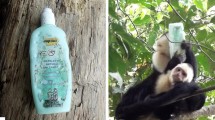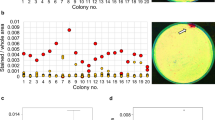Capuchins apply many organic materials, especially leaves, to their skin. Protection against ectoparasites is the most commonly discussed explanation for the behavior. We describe fur rubbing with carpenter ants(Camponotus rufipes) by semifree-ranging tufted capuchins(Cebus apella) in the Tietê Ecological Park, São Paulo, Brazil. Carpenter ants produce and secrete high concentrations of formic acid, which repels tick nymphs. Anting occurred significantly more often during months of seasonal incidence of nymphs of the tick Amblyomma cajennense, and the behavior was not related to ant-eating. We argue that anting behavior in tufted capuchins fits the hypothesis of protection against ectoparasites.

Similar content being viewed by others
REFERENCES
Altmann, J. (1974). Observational study of behavior: Sampling methods. Behaviour 49: 227–265.
Baker, M. (1996). Fur rubbing: Use of medicinal plants by capuchin monkeys (Cebus capucinus). Am. J. Primatol. 38: 263–270.
Bernard, F. (1968). Les Fourmis (Hymenoptera, Formicidae)—Faune de L’Europe et du bassin méditerranéen, Vol. 3. Masson et Cie Editeurs. Paris, pp. 19–21.
Birkinshaw, C. R. (1999). Use of millipedes by black lemurs to anoint their bodies. Folia Primatol. 70: 170–171.
Campbell, C. (2000). Fur rubbing behavior in free-ranging black-handed spider monkeys (Ateles geoffroyi) in Panama. Am. J. Primatol. 51: 205–208.
DeJoseph, M., Taylor, R. S., Baker, M., and Aregulin, M. (2002). Fur-rubbing behavior of capuchin monkeys. J. Acad. Dermatol. 46: 924–925.
Falótico, T., Verderane, M. P., Resende, B. D., Labruna, M. B., Izar, P., and Ottoni, E. B. (2004). Anting in a semi-free-ranging group of brown capuchin monkeys (Cebus apella). Folia Primatol. 75 (Suppl 1): 372.
Ferreira, R. G., Resende B. D., Mannu, M., Ottoni, E. B., and Izar, P. (2002). Bird predation and prey-transference in brown capuchin monkeys (Cebus apella). Neotrop. Primates 10: 84–89.
Hölldobler, B., and Wilson, E. O. (1990). The Ants. The Belkman Press of Harvard University, Cambridge, MA.
Huffman, M. A. (1997). Current evidence for self-medication in primates: A multidisciplinary perspective. Yrbk Phys. Anthropol. 40: 171–200.
Huffman, M. A. (2001). Self-medicative behavior in the African great apes: An evolutionary perspective into the origins of human traditional medicine. BioScience 51: 651–381.
Huffman, M. A. (2003). Animal self-medication and ethnomedicine: Exploration and exploitation of the medicinal properties of plants. Proc. Nutr. Soc. 62: 371–381.
Judson, O. P., and Bennett, A. T. D. (1992). “Anting” as food preparation: Formic acid is worse on an empty stomach. Behav. Ecol. Sociobiol. 31: 437–439.
Kohl, E., Hölldobler, B., and Bestmann, H. J. (2001). Trail and recruitment pheromones in Camponotus socius (Hymenoptera: Formicidae). Chemoecology 11: 67–73.
Labruna, M. B., Paula, C. D., Lima, T. F., and Sana, D. A. (2002a). Ticks (Acari: Ixodidae) on wild animals from the Porto-Primavera hydroeletric power satation area, Brazil. Mem. Inst. Oswaldo Cruz 97: 1133–1136.
Labruna, M. B., Kasai, N., Ferreira, F., Faccini, J. L. H., and Gennari, S. M. (2002b). Seasonal dynamics of ticks (Acari: Ixodidae) on horses in the state of São Paulo, Brazil. Vet. Parasitol. 105: 65–77.
Longino, J. T. (1984). True anting by the capuchin, Cebus capucinus. Primates 25: 243–245.
Mannu, M. (2002). Uso espontâneo de ferramentas por macacos-prego em condições de semi-liberdade: Discrição e demografia. Dissertação de Mestrado. Departamento de Psicologia Experimental, Instituto de Psicologia, Universidade de São Paulo.
Nolte, A. (1958). Beobachtungen über das instinktverhalten von kapuzineraffen (Cebus apella) in der gefangenschaft. Behaviour 12: 183–207.
Oppenheimer, J. R. (1977). Communication in New World monkeys. In How Animals Communicate. T. A. Sebeok Ed. Indiana University Press, Bloomington, pp. 851–889.
Ottoni, E. B., and Mannu, M. (2001). Semifree-ranging tufted capuchins (Cebus apella) spontaneously use tools to crack open nuts. Int. J. Primatol. 22: 347–358.
Ottoni, E. B., Resende, B. D., and Izar, P. (2005). Watching the best nutcrackers: What capuchin monkeys (Cebus apella) know about others’ tool-using skills. Anim. Cognit. 8: 215–219.
Resende, B. D., Mannu, M., Izar, P., and Ottoni, E. B. (2004). Interactions between capuchin monkeys (Cebus apella) and coatis (Nasua nasua): Non-agonistic behaviors and lack of predation. Int. J. Primatol. 25: 1213–1224.
Simmons, K. E. L. (1966). Anting and the problem of self-stimulation. J. Zool. Lond. 149: 145–162.
Valderrama, X, Robinson, J. G., Attygalle, A. B., and Eisner, T. (2000). Seasonal anointment with millipedes in a wild primate: A chemical defense against insects? J. Chem. Ecol. 26: 2781–2790.
Weldon, P. J., Aldrich, J. R., Klun, J. A., Oliver, J. E., and Debboun, M. (2003). Benzoquinones from millipedes deter mosquitoes and elicit self-anointing in capuchin monkeys (Cebus spp.). Naturwissenchaften 90: 301–304.
ACKNOWLEDGMENTS
This work was supported by FAPESP (E. B. Ottoni: 03/10270-3, T. Falótico: 03/03094-4, M. P. Verderane: 03/03095-0, B. D. Resende: 99/11573-2) and CAPES (P. Izar: 00022/03-9). We thank Tietê Ecological Park for permission to conduct the study and Maria Santina for identification of ants. There is a pending patent for formic acid as a tick repellent (Deposit No. 0762-0044, from 03/24/2005).
Author information
Authors and Affiliations
Corresponding author
Rights and permissions
About this article
Cite this article
Verderane, M.P., Falótico, T., Resende, B.D. et al. Anting in a Semifree-ranging Group of Cebus apella . Int J Primatol 28, 47–53 (2007). https://doi.org/10.1007/s10764-006-9102-8
Published:
Issue Date:
DOI: https://doi.org/10.1007/s10764-006-9102-8




